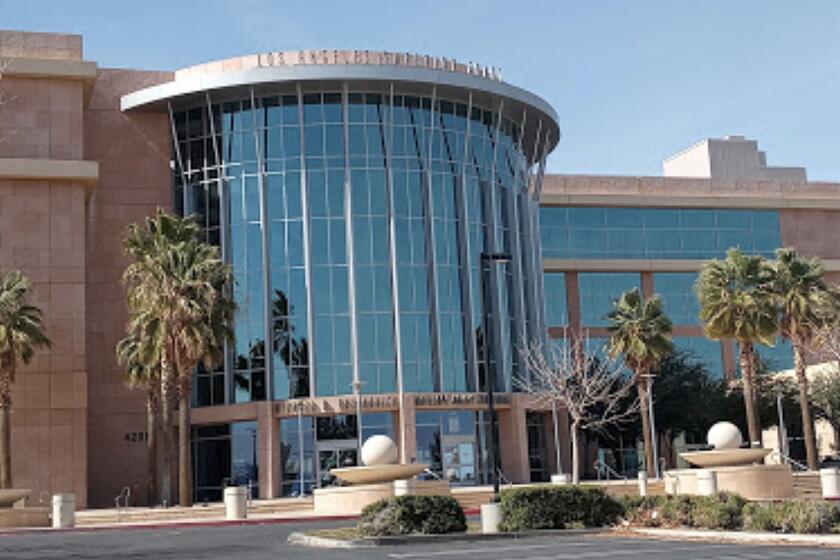Panel OKs Major Changes to Porter Ranch Plan
- Share via
In a move that could completely revise a city-approved plan for a massive development in the Porter Ranch area, the Los Angeles Planning Commission on Thursday approved significant changes in the massive project and set a timetable to overhaul the entire plan.
The Porter Ranch Development Co. received permission to replace a planned office, retail and hotel complex planned for the hills above the 118 Freeway with a 660,000-square-foot shopping center.
Along with that change, the company got approval to make an extension of Winnetka Avenue narrower than previously planned, and add previously forbidden establishments such as drive-throughs. And the company will no longer have to build certain pedestrian bridges and motorized walkways.
In 1993, the development company, which previously built 2,100 homes in the foothills, received permission to build about 3,000 additional homes and 6 million square feet of commercial space.
The proposal won approval after years of contentious debate and community input, and the fracas over it almost cost City Councilman Hal Bernson, who represents the area, his job.
But if the City Council goes along with the Planning Commission, the so-called specific plan, or community plan, could well be completely overhauled during the next two years.
Under Thursday’s decision, the sweeping changes for the commercial area would be accompanied by an 18-month study on ways to change the rest of the project.
“It’s like hocus-pocus,” said community activist Don Worsham after the vote. “Now you see the plan, and now you don’t.”
According to supporters, these changes should be welcome because they actually mean that less, not more, would be built on the thus-far untarnished hillsides.
“I am amazed that people are opposed to this,” said Commissioner Robert Prince, who, like all of his colleagues except Anthony Zamora, who was absent, voted for the changes.
Bernson has not yet taken a position on the proposal, but his planning deputy said the councilman “can understand the need for a smaller center” and hopes to further reduce the scope of the project over time.
But community activist Walter Prince, who for years led the fight against the development, said the Planning Commission did not follow the proper process for amending the plan.
Instead of granting the developer’s changes, he said, the commission should have begun the process of reviewing and amending the plan itself, so that community members could have input on how the site would be used.
If the council endorses the commission’s move, Walter Prince said, “Everything is wiped out that the community worked on for years.”
The decision opens the entire plan for modifications, agreed Tom Stemnock, a consultant who represents the development company. The firm, he said, is mostly concerned about changing plans for commercial space. The housing component is likely to stay the same.
Richard Mahan, spokesman for Porter Ranch Development Co., said most of the changes approved Thursday are simply part of the developer’s attempt to scale down the project.
For instance, he said, Winnetka Avenue was ordered widened when the plans called for high-rise offices with thousands of workers. But now, those offices will not be built and it is not necessary to increase the capacity of the street.
Phyllis Winger, Bernson’s planning deputy, said it’s not unusual for carefully worked-out plans to change at the stroke of a pen when a developer decides to build something different. She said this case, however, is unusual because the developer wants to make the project smaller, not larger.
But Prince and others who oppose the project said unless the developer reveals plans for the rest of the site, it is impossible to know whether mitigations such as walkways and widened streets would still be necessary.
Also, they said, the company promised an upscale regional shopping center and is now planning to put up buildings large enough to accommodate warehouse-style discount stores.
Stemnock told the commission that the company did not yet know what tenants would come into the center, but he did describe talks with a pet supply chain that is considering opening a large store with some in-house veterinary services.
He pointed to a development that the same partners had built in Orange County, saying the Home Depot store there was very attractive.
“So if we had a Wal-Mart, it would be the best-looking Wal-Mart in the United States?” asked Scott, the commissioner.
“Right,” Stemnock replied.
More to Read
Sign up for Essential California
The most important California stories and recommendations in your inbox every morning.
You may occasionally receive promotional content from the Los Angeles Times.










